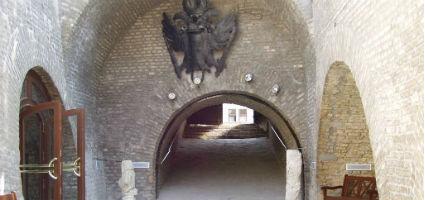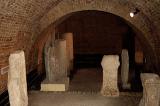2024. April 26. Friday
János Xántus Museum - Castle Underground Channel - Stone Store - Győr
 |
Address: 9021, Győr Bécsi kapu tér 5.
Phone number: (96) 310-588
E-mail: xantus@gymsmuzeum.hu
Opening hours: 24.05-30.09.: Tue-Sun 10-18
|
Győr, the centre of the county governor was a fortified place from as early as the age of King Saint Stephen (1000-1038). The medieval castle encircled the Chapter Hill (Káptalandomb). The strategic importance of the castle was enlarged during the Turkish Age (16-17th centuries) when becoming the strongest fortress of the defence line it played the part of the defence bastion of the emperor's city (Vienna) and the whole Christian World.
As a result of the fortification efforts, which started in 1537 under the rule of Emperor (and Hungarian King) Ferdinand I and went on for forty years, the whole town was enclosed with walls having been fortified with seven pentagonal bastions and one demi-bastion. Inside the bastions built of bricks casemates were developed, from where the canons and the defending fire could covere the neighbouring bastions and the curtain side of the wall. The bastions were connected with casemate walkways inside the walls.
The designs following the most up-to-date military architectural principles were made by Italian fortification building masters: Francisco Benigno, Bernardo Gabelli, Pietro Ferabosco, Bernardo de Magno who were also in charge of the construction works. From the one-time enormous fortification only the Castle Bastion encircling the Chapter Hill and the Sforza Demi-bastion defending the Viennese Gate survived.
In the yard and casemates of the Sforza Demi-bastion the Lapidary of the János Xántus Museum can be seen. Three gates had offered an entrance into the town until the middle of the 19th century when they were demolished. The most representative of the gates: the Viennese Gate (1568), which resembled the antic triumphal arches, was built according to one of the fort-gate designs of the sample book of the famous Italian architect, Sebastiano Serilo. The gate structure was decorated by the Habsburg imperial coat of arms representing a double-headed eagle, the striped coat of arms of the Hungarian Kings, the Czech royal coat of arms with lion and an inscription enlisting the titles of Emperor Maximilian II the fragments of which as well as a fragment of the Doric entablature of the Water Gate (1567) can be seen under the arches of the Lapidary yard.
Following a lengthy siege in 1594 the Turkish army captured the fortress. However, they could not be happy with their new conquest, since during the night of 28th and 29th March 1598 the Christian troops managed to retake it by a sudden attack. The Christians marshalled by Adolf von Schwarzenberg and Miklós Pálffy blew up the Fehérvár Gate by a powerful squib, than they invaded the town. A fragment of the destroyed wing of the gate has been preserved as a precious relic of the liberation and can also be seen in the yard of the Lapidary.
The development of the military art by the middle of the 17th century required a modernisation of the fortifications. It was made during the commandership of Count Montecuccoli between 1661 and 1664 based on the plans of the military engineer F. Wymes. An extra chain of ramparts was built at the outer side of the extended ditches.
With the termination of the Turkish wars at the end of the 18th century the Castle of Győr lost its military significance but the Napoleonic Wars brought its importance back for a brief period. After the Battle of Kismegyer (today a suburb of Győr) in 1809 the French troops captured the fortified town after some days of siege, than upon their retreat they blew up the walls. During the coming decades the authorities of Győr had the remains of the fortification demolished.
As a result of the fortification efforts, which started in 1537 under the rule of Emperor (and Hungarian King) Ferdinand I and went on for forty years, the whole town was enclosed with walls having been fortified with seven pentagonal bastions and one demi-bastion. Inside the bastions built of bricks casemates were developed, from where the canons and the defending fire could covere the neighbouring bastions and the curtain side of the wall. The bastions were connected with casemate walkways inside the walls.
The designs following the most up-to-date military architectural principles were made by Italian fortification building masters: Francisco Benigno, Bernardo Gabelli, Pietro Ferabosco, Bernardo de Magno who were also in charge of the construction works. From the one-time enormous fortification only the Castle Bastion encircling the Chapter Hill and the Sforza Demi-bastion defending the Viennese Gate survived.
In the yard and casemates of the Sforza Demi-bastion the Lapidary of the János Xántus Museum can be seen. Three gates had offered an entrance into the town until the middle of the 19th century when they were demolished. The most representative of the gates: the Viennese Gate (1568), which resembled the antic triumphal arches, was built according to one of the fort-gate designs of the sample book of the famous Italian architect, Sebastiano Serilo. The gate structure was decorated by the Habsburg imperial coat of arms representing a double-headed eagle, the striped coat of arms of the Hungarian Kings, the Czech royal coat of arms with lion and an inscription enlisting the titles of Emperor Maximilian II the fragments of which as well as a fragment of the Doric entablature of the Water Gate (1567) can be seen under the arches of the Lapidary yard.
Following a lengthy siege in 1594 the Turkish army captured the fortress. However, they could not be happy with their new conquest, since during the night of 28th and 29th March 1598 the Christian troops managed to retake it by a sudden attack. The Christians marshalled by Adolf von Schwarzenberg and Miklós Pálffy blew up the Fehérvár Gate by a powerful squib, than they invaded the town. A fragment of the destroyed wing of the gate has been preserved as a precious relic of the liberation and can also be seen in the yard of the Lapidary.
The development of the military art by the middle of the 17th century required a modernisation of the fortifications. It was made during the commandership of Count Montecuccoli between 1661 and 1664 based on the plans of the military engineer F. Wymes. An extra chain of ramparts was built at the outer side of the extended ditches.
With the termination of the Turkish wars at the end of the 18th century the Castle of Győr lost its military significance but the Napoleonic Wars brought its importance back for a brief period. After the Battle of Kismegyer (today a suburb of Győr) in 1809 the French troops captured the fortified town after some days of siege, than upon their retreat they blew up the walls. During the coming decades the authorities of Győr had the remains of the fortification demolished.
